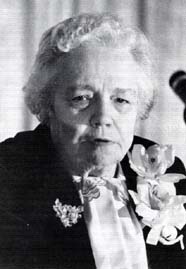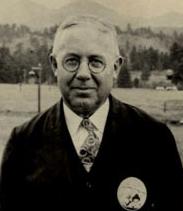Related Research Articles

A credit union is a member-owned nonprofit cooperative financial institution.

Louise McCarren Herring, was an Ohio native, recognized as one of the pioneer leaders of the not-for-profit cooperative credit union movement in the United States. Herring is universally regarded in the United States credit union movement as being the “Mother of Credit Unions” for her work with the movement since its earliest days.

Catherine Filene Shouse was an American researcher and philanthropist. She graduated in 1918 from Wheaton College in Norton, Massachusetts. She worked for the Women's Division of the U.S. Employment Service of the Department of Labor, and was the first woman appointed to the Democratic National Committee in 1925. She was also the editor of the Woman's National Democratic Committee's Bulletin (1929–32), and the first woman to chair the Federal Prison for Women Board.

The Credit Union National Association, commonly known as CUNA, is a national trade association for both state- and federally chartered credit unions located in the United States. CUNA provides member credit unions with trade association services, such as lobbying, regulatory advocacy, professional development, and professional services management. The organization operates out of its headquarters in Washington, D.C., and an operations center in Madison, Wisconsin. CUNA's president and chief executive officer Jim Nussle has led the organization since September 2014.
A credit union league or credit union central is cooperative federation for credit unions.

Edward Albert Filene was an American businessman and philanthropist. He is best known for building the Filene's department store chain and for his decisive role in pioneering credit unions across the United States.

The Federal Credit Union Act is an Act of Congress enacted in 1934. The purpose of the law was to make credit available and promote thrift through a national system of nonprofit, cooperative credit unions. This Act established the federal credit union system and created the Bureau of Federal Credit Unions, the predecessor to the National Credit Union Administration, to charter and oversee federal credit unions. The general provisions in the Federal Act were based on the Massachusetts Credit Union Act of 1909, and became the basis of many other state credit union laws. Under the provisions of the Federal Credit Union Act, a credit union may be chartered under either federal or state law, a system known as dual chartering, which is still in existence today.

Dora Maxwell was an early credit union pioneer in New York state. Despite having to deal with intimidating bankers, she secured charters for hundreds of credit unions throughout the United States. In 1932 Maxwell replaced Basil B Mallicoat as the head of the CUNEB branch and new headquarters called "Eastern State Offices" located on Forty-Second Street in New York, New York. She was a delegate to the 1934 Estes Park conference which established the Credit Union National Association (CUNA) and worked as an organizer for the Credit Union National Extension Bureau, the movement's trade organization. In 1937, she worked alongside Thomas Doig to represent and promote CUNA Mutual Insurance, collect national dues, and generally represent CUNA in the field.

Moses Michael Coady was a Roman Catholic priest, adult educator and co-operative entrepreneur best known for his instrumental role in the Antigonish Movement. Credited with introducing "an entirely new organizational technique: that of action based on preliminary study" to the co-operative movement in Canada, his work sparked a wave of co-operative development across the Maritimes and credit union development across English Canada. Due to his role and influence, he is often compared to Alphonse Desjardins in Québec. The influence of the movement he led spread across Canada in the 1930s and by the 1940s and 1950s, to the Caribbean, Africa and Asia.

The Antigonish Movement blended adult education, co-operatives, microfinance and rural community development to help small, resource-based communities around Canada's Maritimes to improve their economic and social circumstances. A group of priests and educators, including Father Jimmy Tompkins, Father Moses Coady, Rev. Hugh MacPherson and A.B. MacDonald led this movement from a base at the Extension Department at St. Francis Xavier University in Antigonish, Nova Scotia.

Credit unions are not-for-profit financial cooperatives. In the early stages of development of a nation's financial system, unserved and underserved populations must rely on risky and expensive informal financial services from sources like money lenders, ROSCAs and saving at home. Credit unions proved they could meet demand for financial services that banks could not: from professional, middle class and poorer people. Those that served poorer urban and rural communities became an important source of microfinance.

The Canadian Credit Union Association is the national trade association for credit unions in Canada. Founded in 1953, it rebranded to its current name in January 2016 to reflect its "evolving role as an association that is focused on growing a stronger... credit union industry."

America's Credit Union Museum is located in Manchester, New Hampshire, on the site of the first credit union founded in the United States. The museum is housed at the original location for St. Mary's Cooperative Credit Association, renamed in 1925 to La Caisse Populaire Ste.-Marie, or "Bank of the People", St. Mary's. In 1996, the building was listed on the National Register of Historic Places as the Building at 418–420 Notre Dame Ave.
The Filene Research Institute is an American credit union and consumer finance think tank headquartered in Madison, Wisconsin.

The Union Credit Union was a credit union chartered to serve union members. A national advocate for unions and union members, it was headquartered in Spokane, Washington, United States. It closed operations in October 2010.

Credit unions in the United States served 100 million members, comprising 43.7% of the economically active population, in 2014. U.S. credit unions are not-for-profit, cooperative, tax-exempt organizations. The clients of the credit unions become partners of the financial institution and their presence focuses in certain neighborhoods because they center their services in one specific community. As of March 2020, the largest American credit union was Navy Federal Credit Union, serving U.S. Department of Defense employees, contractors, and families of servicepeople, with over $125 billion in assets and over 9.1 million members. Total credit union assets in the U.S. reached $1 trillion as of March 2012. Approximately 236,000 people were directly employed by credit unions per data derived from the 2012 National Credit Union Administration (NCUA) Credit Union Directory. As of 2019, there were 5,236 federally insured credit unions with 120.4 million members, and deposits of $1.22 trillion.

Roy F. Bergengren was an American attorney and pioneer of the United States credit union movement. Hired by Edward Filene in July 1921 to head the Credit Union National Extension Bureau, Bergengren carried out an ambitious legislative agenda that resulted in the enactment of the Federal Credit Union Act, the creation of the Credit Union National Association (CUNA), and the foundation of thousands of credit unions across the United States.

Summit Credit Union, founded in 1935, is a credit union that was once based in Madison, Wisconsin, United States. In 2019 they moved their headquarters to nearby Cottage Grove, Wisconsin. Since April 2022, it has 49 locations throughout the state. Summit has more than 227,000 members and $4.9 billion in assets, making it one of the largest credit unions in the state. Summit Credit Union is regulated by the National Credit Union Administration (NCUA) as a federally insured state-chartered credit union. It was officially chartered in 1935 and was assigned NCUA charter number 67190.

The Association of Vermont Credit Unions is a federated trade association composed of twenty state and federally chartered credit unions that is itself a member of the Credit Union National Association. Founded as the "Vermont Credit Union League" in 1947, the Association's responsibilities include lobbying the state legislators in Montpelier on behalf of its member credit unions, representing credit union interest to pertinent regulators, administering statewide marketing and youth financial education programs, providing education and information sharing among credit union employees and officials, and delivering certain back-office operational support programs to credit unions including a cooperative ATM/debit card program to a majority of credit unions throughout Vermont. It is headquartered in Colchester.

Fr. Marion M. Ganey, S.J., (1904–1984) was an American Catholic priest, member of the Society of Jesus (Jesuits), and missionary to British Honduras, Central America, from 1937 to 1953, where he was instigator of the credit union and cooperatives movement. He became increasingly prominent in this movement, being invited to the Fiji Islands in 1953 and laboring to establish the movement there and throughout the South Pacific until his death in Fiji in 1984.
References
- ↑ Teresed, Swen. Dictated But ---- Not Read. The Deseret News. 14 December 1937.
- ↑ Bergengren, Roy. Credit Union North America., p. 100
- ↑ Johnson, Gerald W. Liberal's Progress. Coward-McCowan Inc., New York, 1948, p. 218
- ↑ Johnson, Gerald W. Liberal's Progress. Coward-McCowan Inc., New York, 1948, p. 219